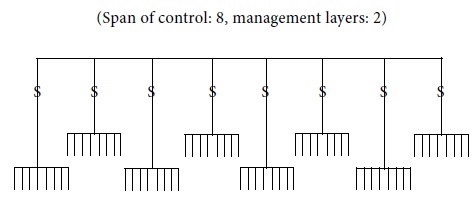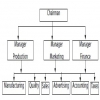Home | ARTS | Management Concepts & Organisational Behaviour
|
Span of Management and the Levels - Organisation Structure And Design
Management Concepts & Organisational Behaviour - Organisation Structure And Design
Span of Management and the Levels - Organisation Structure And Design
Posted On :

The limitation on the part of a manager to manage an infinite number of subordinate obviously results in the levels in the organization.
Span of Management and the
Levels
The limitation on the part of a manager to manage an infinite number of subordinate obviously results in the levels in the organization. Thus, an inverse relationship generally exists between the span of management and number of management levels. That is, if an organization has wide span, the resulting structure will be flat, with few levels of management. Conversely, is an organization has narrow span; the structure will be tall with many management levels. Both the situations of wide as well as narrow spans and the resulting flat and tall structures are shown in Figure. Company B: Flat structure caused by wide spans of control for 64 operative employees.

As presented in the above figures, in Company A, each supervisor’s span covers four subordinates, and four department heads report to the chairman. There are a total of 21 managers, arranged in four management levels. In contrast, in company B, each of the eight supervisors exercise controls over eight subordinates. As a result, there exists only three layers. In this case, by increasing the span from four to eight, one layer of management is eliminated.
Creation of too many levels has certain problems related to the costs associated with communication and managerial control.
Costs: Levels are costly. Too many levels involve lot of expenditure. Additional facilities in terms of secretarial staff have to be provided besides the pay differentials in the compensation package. In many organizations substantial expenditure has been saved by increasing the span.
Communication: Successive layers of management act as communication filters distorting the transmission of information. Experience shows that the greater the number of management levels a message must pass through, the longer it will take to reach its destination. More often, the information also looses clarity. Thus, communication or organizational objectives, plans and policies become difficult. Omissions and misinterpretations usually occur as information passes through too many levels in the scalar chain.
Managerial control: The distance between the top and bottom levels of an organization also affects control. For example, even the best of the plans which are definite and complete at the top level lose clarity as the plans are sub-divided and elaborated at lower levels. Consequently, at the implementation stage of the plan, control becomes difficult.
The limitation on the part of a manager to manage an infinite number of subordinate obviously results in the levels in the organization. Thus, an inverse relationship generally exists between the span of management and number of management levels. That is, if an organization has wide span, the resulting structure will be flat, with few levels of management. Conversely, is an organization has narrow span; the structure will be tall with many management levels. Both the situations of wide as well as narrow spans and the resulting flat and tall structures are shown in Figure. Company B: Flat structure caused by wide spans of control for 64 operative employees.


As presented in the above figures, in Company A, each supervisor’s span covers four subordinates, and four department heads report to the chairman. There are a total of 21 managers, arranged in four management levels. In contrast, in company B, each of the eight supervisors exercise controls over eight subordinates. As a result, there exists only three layers. In this case, by increasing the span from four to eight, one layer of management is eliminated.
Problems with levels
Creation of too many levels has certain problems related to the costs associated with communication and managerial control.
Costs: Levels are costly. Too many levels involve lot of expenditure. Additional facilities in terms of secretarial staff have to be provided besides the pay differentials in the compensation package. In many organizations substantial expenditure has been saved by increasing the span.
Communication: Successive layers of management act as communication filters distorting the transmission of information. Experience shows that the greater the number of management levels a message must pass through, the longer it will take to reach its destination. More often, the information also looses clarity. Thus, communication or organizational objectives, plans and policies become difficult. Omissions and misinterpretations usually occur as information passes through too many levels in the scalar chain.
Managerial control: The distance between the top and bottom levels of an organization also affects control. For example, even the best of the plans which are definite and complete at the top level lose clarity as the plans are sub-divided and elaborated at lower levels. Consequently, at the implementation stage of the plan, control becomes difficult.
Tags : Management Concepts & Organisational Behaviour - Organisation Structure And Design
Last 30 days 1399 views














